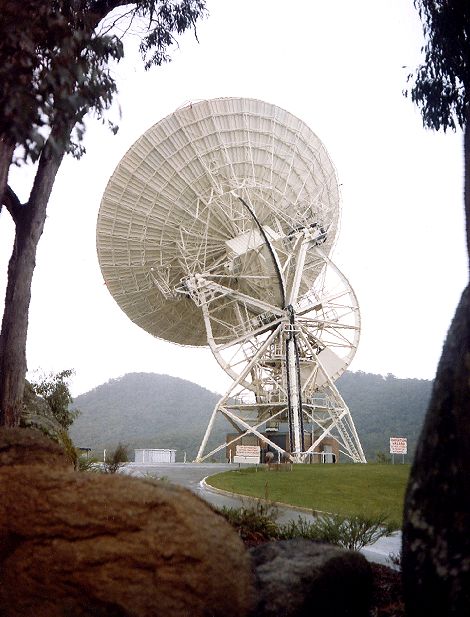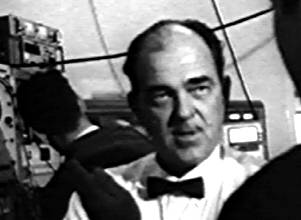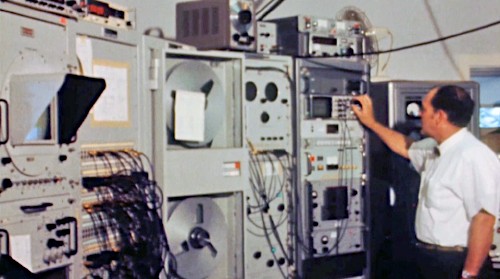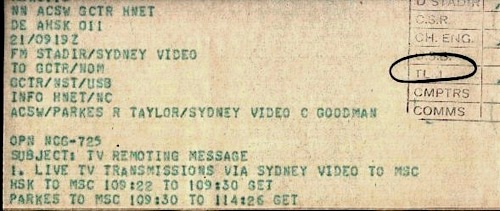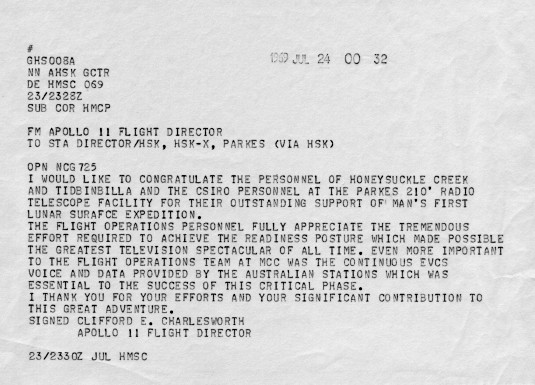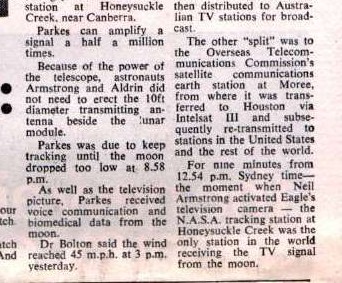|
|
|
The
world watches through Honeysuckle Creek as Neil Armstrong steps
onto the Moon.
Hamish
Lindsay, who took this photo, writes –
“This picture was taken of the HSK antenna
tracking the Apollo 11 Lunar Module just before Armstrong took his first
step onto the lunar surface.
Tom
Reid, the Station Director, sent me out to record the moment. It was
a wet and cold mid-winter morning – we were suffering sleet showers
at the time which you can see on the hills behind.”
Large, Larger.
|
Over the years since 1969, there has
been friendly debate between Parkes and Honeysuckle as to who had the TV at
the first step.
While there was no competition between the
stations – and everyone expected the video to be taken from Goldstone (because
the EVA was called early, and because the signal path from Goldstone to Houston
was considerably shorter) – it is now clear that the first
few minutes of TV came through Goldstone, but that Houston switched to
Honeysuckle Creek just before Neil Armstrong’s first step.
The picture from Parkes was used from about
9 minutes into the TV broadcast.
So what happened?
Problems at Goldstone
At Goldstone they were having problems
with their TV.
Although the slow scan TV picture being received
at Goldstone was excellent (see the one of
only two known surviving Goldstone slow scan photos here), once the slow
scan video was scan-converted, it became almost unusable.
It appears that Goldstone’s scan converter
had been set incorrectly, resulting in a very dark picture with high contrast.
As well, at the start of the broadcast, at
Goldstone the toggle switch to invert the TV image (due to the TV camera being
mounted upside down on the MESA on the side of the Lunar Module) was in wrong position when the TV came on-line.
All this made it very difficult initially to
work out what was what. (Capcom Bruce McCandless was very impressive when he immediately preceived the picture was upside down!)
Several minutes into the EVA the Goldstone
picture was sent out as a negative image – apparently due to the Goldstone
video operator attempting to improve the picture.
Remember, all this happened very quickly, with
no time for experimenting with settings or troubleshooting problems. From the
moment the television camera was turned on – to when Armstrong stepped
on the Moon spanned only 2 minutes and 20 seconds!
The Switch to Honeysuckle
Thus, with Honeysuckle Creek being the
only other source of video, the Houston TV controller Ed Tarkington switched
to the picture coming from Honeysuckle – just before Neil Armstrong stepped
onto the lunar surface.
Note: In Australia, the local networks were taking a split
off the feed going from Sydney Video to Houston. Except for the first few
seconds of the broadcast taken by satellite from the ‘international’
version originating in Houston, Australians saw the TV from Honeysuckle and
then Parkes throughout.
See The Australian TV broadcast for the story – and a relatively recently discovered recording of the start of the
Moonwalk as seen only in Australia.
When did Parkes come on line?
In John Sarkissian’s paper, “On
Eagle’s Wings: The Parkes Observatory’s Support of the Apollo 11 Mission”
published for the Apollo 11 30th anniversary in 1999, a helpful
animation shows that, at the start of the TV broadcast, Parkes could not
see the Moon using its on-axis main beam receiver (not until 03:02UTC). The
Moon was simply too low.
However, it was possible, from 02:54UTC, for
the off-axis receiver to be receiving data.
So what actually happened?
The TV broadcast started at 02:54:00UTC
according to John Saxon’s log – and Armstrong set foot on the Moon
at around 02:56:25 +/- a few seconds...
|
|
|
Part of John Saxon’s log at the
Ops console.
Times are GMT (UTC).
Click the image for the complete page.
And see the full
Honeysuckle log for Apollo 11 here.
With thanks to John Saxon for the scan. |
In order to follow the sequence, one other
important source document is invaluable – a recording made at Honeysuckle
Creek, of NET 2 (the NASA tracking network) mixed with Alpha (the internal
Operations comms loop at Honeysuckle).
To follow the sequence –
Keep in mind that while Parkes’ TV signal was
going direct to OTC Sydney in Paddington, all the rest of the Parkes data
was being sent to Honeysuckle – so the technicians and engineers at Honeysuckle
knew when the Parkes data started coming in. (Mike
Dinn was responsible for integrating Parkes into the network through Honeysuckle.)
The audio recording made at Honeysuckle indicates that Honeysuckle
began processing Parkes data 8 minutes after the TV began. Previously,
there is no mention of data from Parkes, but from that time there is discussion
of how the Parkes data is being demodulated at Honeysuckle.
Why was this?
Robert Taylor from the Goddard Space Flight Center,
who led the NASA contingent at Parkes, controlled the releasing of data from
Parkes to the Network. As far as the Network people were concerned, the data
(especially from the astronauts’ Portable Life Support Systems) was far
more important than the TV. Experienced space trackers are convinced he would
not have allowed data to be sent until Parkes had a stable signal on the main
beam.
This would fit with the audio recording made at Honeysuckle.
|
|
|
Robert Taylor, from
the Goddard Space Flight Center, headed the NASA contingent at Parkes.
From an Australian Information Service film showing the preparations
at Parkes. (with thanks to John Sarkissian.)
Hear Bob Taylor explain Parkes’ integration into the MSFN in this 780kb mp3 file recorded at Parkes in July 1969. |
|
Robert Taylor with the NASA equipment in the Parkes control room several days before the lunar landing. The Parkes control desk is just out of view to the right, around the central column.
The slow scan monitor is at far left.
Photo is a screenshot from NASA footage, courtesy of Mark Gray. |
To ensure the integrity of the data lines to Honeysuckle,
Parkes was sending a multiburst ‘test signal’ down the line until
they were ready to send data.
At Honeysuckle, this multiburst signal was received until
just before Station Director Tom Reid (at the prompting of Deputy Director Mike
Dinn, who was on the phone to Parkes) asked SDDS operator Kevin Gallegos if
Parkes data was now being received.
Note the convergence here (on the recording
above made at Honeysuckle) –
08'00" – “can you confirm that we are receiving
Parkes data?” – Honeysuckle Director Tom Reid indicating he
has been told Parkes now had a good lock – and
08'42" – Charlie Goodman advising Houston that he had a “very
good picture from Parkes”
To summarise:
While it’s quite possible that Parkes was receiving data (including slow
scan TV) from near the start of the broadcast, evidently it was not of sufficient
quality and stability to send on to either Honeysuckle or to Sydney
Video.
At 8 minutes into the TV, Honeysuckle Station Director
Tom Reid asked SDDS operator Kevin Gallegos to confirm that Parkes data was
now coming in. When it was confirmed, the demodulating of the Parkes signal
was discussed.
Thirty-six seconds after Tom Reid’s first mention
of Parkes, and just 3 seconds after Kevin Gallegos begins the demodulation
at Honeysuckle, Charlie Goodman – the NASA controller at Sydney OTC responsible
for choosing between Parkes and Honeysuckle’s TV – announces that
he has “a very good picture from Parkes”. Obviously, he hadn’t
earlier.
This doesn’t mean that the people at Parkes
didn’t see the first step – as John Sarkissian’s animation shows,
they probably did – (as those at Parkes on the day recall) but it
seems likely that the NASA network people at Parkes (led by Bob Taylor) exercised
their usual caution and did not release the data (probably including the TV)
to the network until they were confident there was a stable signal on the main
beam.
This seems to be confirmed by John Saxon’s Honeysuckle
station log (above) that at 03:06UTC Honeysuckle is now processing
Parkes data. “Parkes up using their TV and PAM -90dbm”.
What if TV was being sent from Parkes from the start?
At Sydney Video, the NASA controller Charlie Goodman,
would have been aware of any initial TV that may have been coming from Parkes
from their off-axis receiver. However, with a perfectly acceptable (though more noisy)
television picture coming from the smaller antenna at Honeysuckle, he elected
to stay with that until Parkes had its signal on the main beam. To switch to
an off-axis signal with the knowledge that it would be lost for a minute or
so (or maybe longer) when Parkes changed to the main receiver would have been
considered risky.
To compound problems Parkes’ problems, unprecedented
wind gusts were buffetting the dish and could have made the off-axis signal
more prone to dropouts. (And great credit goes to Neil ‘Fox’ Mason
who was driving the telescope – and the rest of the team at Parkes who
kept tracking, despite the wind storm which threatened the integrity of the
1000 tonne antenna directly above them.)
|
|
|
This TWX (pronounced
“twix” – Network teletype message) was sent by the Honeysuckle
Station Director on behalf of Sydney Video (who probably didn’t
have TWX facilities) to the Goddard Networks Operations Manager –
at 7:19pm AEST on Monday 21st July 1969 – only four hours after
the lunar EVA had finished.
The TWX lists Sydney Video as sending Honeysuckle
Creek pictures to the Manned Spacecraft Center in Houston from 109
hours 22 minutes Ground Elacpsed Time (the start of the TV) to 109 hours
30 minutes Ground Elapsed Time – and then Parkes pictures
for the rest of the EVA.
With thanks to Honeysuckle Video tech Ed von Renouard
for the scan.
John Saxon has kindly deciphered the abbreviations –
“This is a routine (NN) message to Canberra switching centre (ACSW)
and Goddard (GCTR) and Houston Network (HNET).
The message is from (DE) HSK (AHSK) – the originator is
Station Director (nominally Tom Reid – but could have been written
by someone else) using input from Sydney Video.
The message goes to Goddard NOM (Networks Operations Manager)
and NST/USB (Network Support Team USB position) for action if
required.
Info copies (cc these days!) were sent to Houston Network team
(HNET) NC (Network Controller – Ernie Randall?). Also to
Canberra Switch (ACSW) for forwarding to Parkes and Sydney Video.
The 21/0919Z is the Date/Time Group (DTG) of transmission –
sent at 0919Z (7:19pm local) on the 21st July 1969 – I think the year
might have been on the Time of Preparation (TOP) on the bottom of the message.
Finally it was a message of Operations type (OPN) for NCG-725
(Network Control Group number) = Apollo 11.” |
The movie The Dish was a lot of fun – and brought
to light the vital Australian involvement in Apollo – but it re-wrote
history and left people believing that Neil Armstrong’s first step
on the Moon was seen through Parkes.
Hopefully, the material above will help to set the story straight
–
1. The coverage of the EVA began with Goldstone,
2. then continued through Honeysuckle Creek
3. and then Parkes provided the TV for the rest of the EVA. |
The team at Honeysuckle Creek had the unexpected pleasure of bringing the television pictures of the First Step on the Moon to the world.
Other resources
See Mike Dinn’s
article on the topic.
Note of Congratulations from the Apollo 11 Flight
Director
Clifford E. Charlesworth, Apollo 11
Flight Director, sent this congratulatory TWX to Honeysuckle Creek, Tidbinbilla
and Parkes after the Apollo 11 EVA. (Note that while he mentions the TV as ‘the
greatest television spectacular of all time’, it is the voice and data
which is most important to the Flight Operations people.)
|
|
|
John Saxon preserved this copy.
TWXs were printed on multi-ply impact sensitive paper.
John’s copy is a top level one. See another
copy from lower down in the same printout – kept by Mike Dinn,
photo by Colin Mackellar, March 2006.
Bill Wood writes, “This is one page of a Teletype
multi-ply printout. The teleprinters were loaded with special paper that
acted like carbon paper and produced as many as six copies of every message
that came in.” |
“Magnificent Australian Support of Apollo
11”
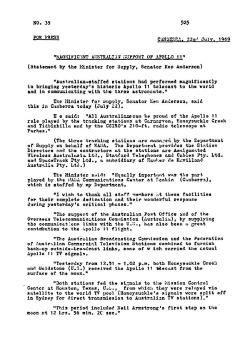 |
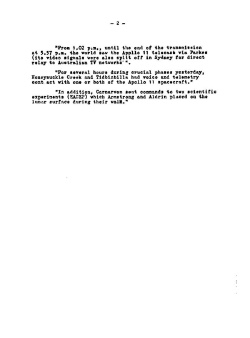 |
This Press Release from the Minister for
Supply, Ken Anderson, the day after the Apollo 11 EVA – Tuesday July
22, 1969, states that Honeysuckle, and then Parkes, provided the TV pictures.
He also pays tribute to the work of NASCOM at Deakin.
(Provided by Mike Dinn. Click for larger images.) |
|
This newspaper clipping from the Sydney Morning Herald, Tuesday 22 July 1969, isn’t completely correct at several
points, but it captures the excitement of the day. Scan by Colin Mackellar. |
Back to the
main page for Apollo 11 TV.
